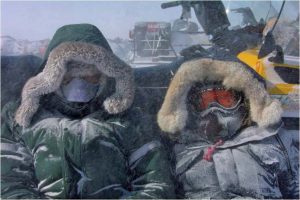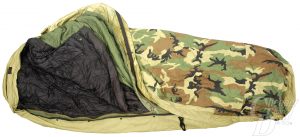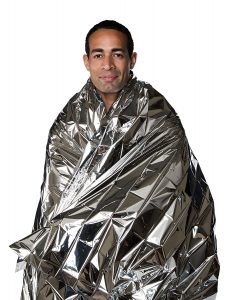Regardless of where you live or what time of year the event occurs, you’ll probably need to put some thought into staying dry and warm. Hypothermia can strike even in tropical weather fi you fail to retain body heat. Likewise, if you’re working in the sun or dehydrated, heat stroke can affect you within minutes.
 The most common heat source will undoubtedly be fire, coming from several different sources: wood or other combustibles, charcoal grills, gas grills, kerosene heaters, and space heaters. I shouldn’t have to say this but since 430 people die each year from carbon monoxide poisoning…. here we go: Don’t use your charcoal or propane grill inside a closed space! This also holds true for any other type of heater, even a fireplace if it is not properly ventilated. If you’re not familiar with how your fireplace’s flue works, have someone show you. Most fireplaces are never used and are really considered architectural ornamentation. This is because open hearth fireplaces are incredibly inefficient, sending 90% of the heat generated up the chimney. Most fireplaces suck the heated air out of a room, causing a cold draft of vented air. The flue must be open to ventilate the living space and prevent smoke from backing up into the house. If you decide to heat with an unvented kerosene, natural gas or fuel oil heater, make sure to crack some windows to allow enough air inside – otherwise the heaters consume all the oxygen in the room while you’re asleep. Not good. One early sign that your gas or kerosene heater isn’t properly vented will be condensation on windows and walls. If you see this happening, open a window immediately. In view of the risks of having a heat source inside a living space, they’re best avoided altogether. Instead, focus on retaining your body heat and avoid losing it in the first place. Then, if you do get cold, heat yourself from an outside fire source.
The most common heat source will undoubtedly be fire, coming from several different sources: wood or other combustibles, charcoal grills, gas grills, kerosene heaters, and space heaters. I shouldn’t have to say this but since 430 people die each year from carbon monoxide poisoning…. here we go: Don’t use your charcoal or propane grill inside a closed space! This also holds true for any other type of heater, even a fireplace if it is not properly ventilated. If you’re not familiar with how your fireplace’s flue works, have someone show you. Most fireplaces are never used and are really considered architectural ornamentation. This is because open hearth fireplaces are incredibly inefficient, sending 90% of the heat generated up the chimney. Most fireplaces suck the heated air out of a room, causing a cold draft of vented air. The flue must be open to ventilate the living space and prevent smoke from backing up into the house. If you decide to heat with an unvented kerosene, natural gas or fuel oil heater, make sure to crack some windows to allow enough air inside – otherwise the heaters consume all the oxygen in the room while you’re asleep. Not good. One early sign that your gas or kerosene heater isn’t properly vented will be condensation on windows and walls. If you see this happening, open a window immediately. In view of the risks of having a heat source inside a living space, they’re best avoided altogether. Instead, focus on retaining your body heat and avoid losing it in the first place. Then, if you do get cold, heat yourself from an outside fire source.
 Clothing. Proper clothing varies depending on season, weather and geography, so there’s no “right” answer. In general, in cold weather dress in several layers so you can remove a layer or two to stay comfortable. Avoid sweating whenever possible because in cold weather it’ll chill you quickly and in hot weather it’ll dehydrate you. Try to stay out of the wind because in cold weather you’ll lose body heat at a greatly increased rate, and in warm weather wind will dehydrate you quickly through perspiration. In cold weather do your best to stay dry because your body loses heat at an exponential rate when you’re wet. If you do get wet, try to change into dry clothing as soon as possible because wet clothes chill your core quickly through evaporation. In hot weather you can cool yourself through evaporation by keeping your clothing wet. Recent studies show that heat loss is proportional to the skin surface area exposed, so the old saying that “40% of your heat is lost through your head” is false. Only 7-10% is lost through your head, so a hat does make a difference, just not as much as previously thought. The frequency and color of urine will tell you if you’re dehydrated. Dark yellow urine is a good indication of dehydration, so drink enough to your urine is slightly yellow or clear. Most people urinate every couple of hours, so if you’re going less frequently your body needs more water. Constipation is another indicator of dehydration, so try to follow up every meal with a long drink to stay… uh, comfortable.
Clothing. Proper clothing varies depending on season, weather and geography, so there’s no “right” answer. In general, in cold weather dress in several layers so you can remove a layer or two to stay comfortable. Avoid sweating whenever possible because in cold weather it’ll chill you quickly and in hot weather it’ll dehydrate you. Try to stay out of the wind because in cold weather you’ll lose body heat at a greatly increased rate, and in warm weather wind will dehydrate you quickly through perspiration. In cold weather do your best to stay dry because your body loses heat at an exponential rate when you’re wet. If you do get wet, try to change into dry clothing as soon as possible because wet clothes chill your core quickly through evaporation. In hot weather you can cool yourself through evaporation by keeping your clothing wet. Recent studies show that heat loss is proportional to the skin surface area exposed, so the old saying that “40% of your heat is lost through your head” is false. Only 7-10% is lost through your head, so a hat does make a difference, just not as much as previously thought. The frequency and color of urine will tell you if you’re dehydrated. Dark yellow urine is a good indication of dehydration, so drink enough to your urine is slightly yellow or clear. Most people urinate every couple of hours, so if you’re going less frequently your body needs more water. Constipation is another indicator of dehydration, so try to follow up every meal with a long drink to stay… uh, comfortable.
Insulation. Metabolism slows during sleep, so staying warm is a challenge. Take off shoes and remove tight-fitting and restrictive clothing to improve circulation. Avoid sleeping on asphalt, concrete, ceramic tiles, or bare ground because they’ll suck heat out of your body. If you must sleep on a hard surface, pile clothing, towels, blankets, dried leaves or other insulating material on top of it before lying down. The goal is to put just as much insulation beneath your body as you put on top. The material really doesn’t make all that much difference as long as it is dry and bulky enough to trap insulating air pockets. I’ve found cotton, wool and fleece to be most useful blanket materials. Cotton is great for summer because its breathable and won’t overheat you. Wool is breathable, moisture-wicking, comfortable and fire resistant. Fleece is bulkier, moisture-wicking, comfortable, and easy to clean. Down or feather filled comforters are efficient insulators but are expensive, difficult to clean, the nylon shells are flammable, and they take a long time to dry if you get them wet. Yet, for some reason down filled “camp blankets” are all the rage right now. No idea why…
 Sleeping Bags. Want a warm night’s sleep? Check out a surplus USGI “modular sleep system” that was designed for multi-season comfort and consists of several layers. They’re tapered, to reduce the amount of unnecessary space inside to retain body heat, and have an overlapping zipper to keep heat from escaping. They’re “mummy” shaped, with a tight closure around your face to prevent heat from escaping. The modern designs using reflective materials are amazingly efficient. Mine has a soft fleece inner liner that’s easy to remove for airing out and cleaning. The main bag contains overlapping layers of insulation to avoid thin cold spots, and is held in a breathable, heat reflective synthetic material. The outer shell is a breathable nylon (Gortex) that prevents perspiration from building up in the bag. Depending on the weather I can add or remove any of the layers. On warm summer nights I use the fleece liner by itself. In colder weather when inside a shelter or tent I use the fleece liner inside the main bag. On winter camping trips I’ll use all three parts and still place layers beneath me and pile my unused clothing on top of the bag (USGI surplus for $69 @ eBay). Another way to conserve heat is to share body heat with others. Two or more rectangular bags can easily be zipped together to offer room for multiple people. These bags are much cheaper than the modular sleep systems, but the tradeoff is that they’ren’t rated for low temperatures. Another lesson learned the hard way: Several years ago I took some kids weekend camping in Prince William National Park. It was Fall but the weather wasn’t at all severe. That evening we had a good meal and the kids stayed up talking around the fire when I went to bed. Around midnight they woke me up and asked if they could sleep in the car because they were all cold. I started the car to warm the kids up and checked their bags and ground cloths and found the insides of their bags moist. It turns out they had all put their heads inside of the bags to keep their faces warm. The moisture in their breaths condensed, causing the bag to lose its insulating ability. Before long, they were all chilled and miserable. Lesson learned: Don’t breathe into your bag. The warmth provided from your breath is temporary.
Sleeping Bags. Want a warm night’s sleep? Check out a surplus USGI “modular sleep system” that was designed for multi-season comfort and consists of several layers. They’re tapered, to reduce the amount of unnecessary space inside to retain body heat, and have an overlapping zipper to keep heat from escaping. They’re “mummy” shaped, with a tight closure around your face to prevent heat from escaping. The modern designs using reflective materials are amazingly efficient. Mine has a soft fleece inner liner that’s easy to remove for airing out and cleaning. The main bag contains overlapping layers of insulation to avoid thin cold spots, and is held in a breathable, heat reflective synthetic material. The outer shell is a breathable nylon (Gortex) that prevents perspiration from building up in the bag. Depending on the weather I can add or remove any of the layers. On warm summer nights I use the fleece liner by itself. In colder weather when inside a shelter or tent I use the fleece liner inside the main bag. On winter camping trips I’ll use all three parts and still place layers beneath me and pile my unused clothing on top of the bag (USGI surplus for $69 @ eBay). Another way to conserve heat is to share body heat with others. Two or more rectangular bags can easily be zipped together to offer room for multiple people. These bags are much cheaper than the modular sleep systems, but the tradeoff is that they’ren’t rated for low temperatures. Another lesson learned the hard way: Several years ago I took some kids weekend camping in Prince William National Park. It was Fall but the weather wasn’t at all severe. That evening we had a good meal and the kids stayed up talking around the fire when I went to bed. Around midnight they woke me up and asked if they could sleep in the car because they were all cold. I started the car to warm the kids up and checked their bags and ground cloths and found the insides of their bags moist. It turns out they had all put their heads inside of the bags to keep their faces warm. The moisture in their breaths condensed, causing the bag to lose its insulating ability. Before long, they were all chilled and miserable. Lesson learned: Don’t breathe into your bag. The warmth provided from your breath is temporary.
 Thermal blankets. I once had a week-long Fall hike ruined by a thermal blanket, sometimes called a “Space Blanket”. In backpacking, weight is king, and guys go to great lengths to lighten their loads. A buddy and I hiked a long section of the Appalachian trail and were settling into a shelter around sundown, which comes pretty early in the Fall. While I was lying down a drop cloth for my sleeping bag, my buddy pulled out a new thermal blanket, still in the wrapper. Folded up it was little bigger than a pack of cigarettes and the package claimed it would “reflect up to 95% of your body heat”. He was convinced that this new “Space Age Technology” had saved him two or three pounds of weight and would be just as warm as his “old sleeping bag”. It didn’t work out that way for him though. When we turned in for the night the temperature was in the low 40s, it was slightly windy and a light drizzle had started. Around 3am he woke me to ask for my ground cloth to wrap around himself. He was wearing all of his clothes and had used a week’s worth of fuel heating up hot drinks to stay warm, but was still shivering and on the verge of hypothermia. He died around breakfast time and I left his dumb ass alongside the trail, enjoying his food for the rest of my week-long hike. Just kidding. His near-freezing clearly signaled the end of our hike and I’ve never gotten tired of teasing him about his “Space Age Technology”. Thermal blankets DO work, just not in those windy, humid conditions that test the best sleeping bags. If my friend had brought a fleece bag liner or blanket to act as insulation and protect him from the heat-sucking breeze and humidity, he would probably have done just fine. Thermal blankets are great tools and really DO reflect a high percentage of your body heat, but you have to use them with insulation to KEEP that heat.
Thermal blankets. I once had a week-long Fall hike ruined by a thermal blanket, sometimes called a “Space Blanket”. In backpacking, weight is king, and guys go to great lengths to lighten their loads. A buddy and I hiked a long section of the Appalachian trail and were settling into a shelter around sundown, which comes pretty early in the Fall. While I was lying down a drop cloth for my sleeping bag, my buddy pulled out a new thermal blanket, still in the wrapper. Folded up it was little bigger than a pack of cigarettes and the package claimed it would “reflect up to 95% of your body heat”. He was convinced that this new “Space Age Technology” had saved him two or three pounds of weight and would be just as warm as his “old sleeping bag”. It didn’t work out that way for him though. When we turned in for the night the temperature was in the low 40s, it was slightly windy and a light drizzle had started. Around 3am he woke me to ask for my ground cloth to wrap around himself. He was wearing all of his clothes and had used a week’s worth of fuel heating up hot drinks to stay warm, but was still shivering and on the verge of hypothermia. He died around breakfast time and I left his dumb ass alongside the trail, enjoying his food for the rest of my week-long hike. Just kidding. His near-freezing clearly signaled the end of our hike and I’ve never gotten tired of teasing him about his “Space Age Technology”. Thermal blankets DO work, just not in those windy, humid conditions that test the best sleeping bags. If my friend had brought a fleece bag liner or blanket to act as insulation and protect him from the heat-sucking breeze and humidity, he would probably have done just fine. Thermal blankets are great tools and really DO reflect a high percentage of your body heat, but you have to use them with insulation to KEEP that heat.